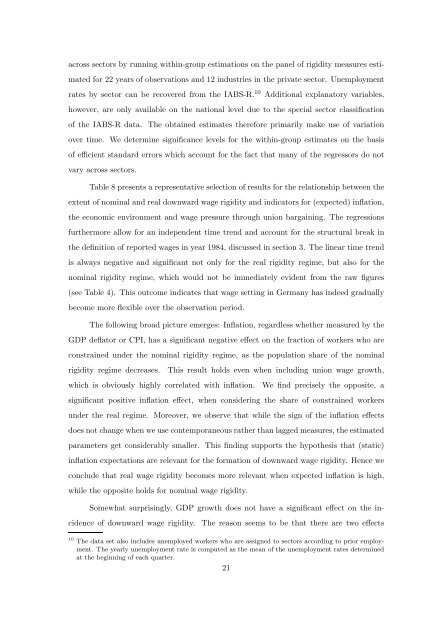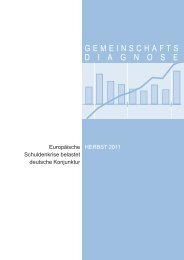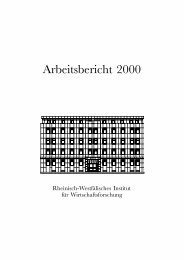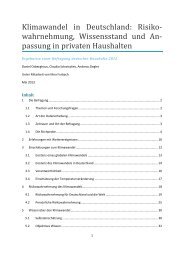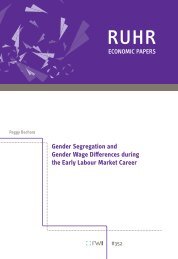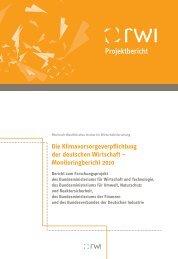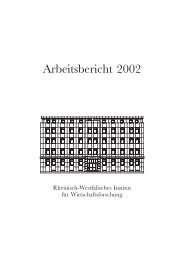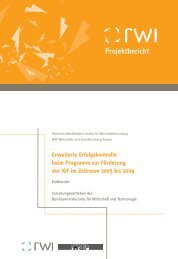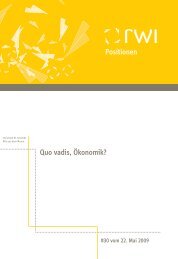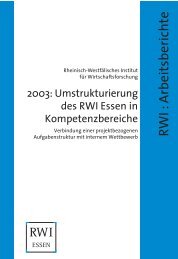RW I:Discussion Papers - Rheinisch-Westfälisches Institut für ...
RW I:Discussion Papers - Rheinisch-Westfälisches Institut für ...
RW I:Discussion Papers - Rheinisch-Westfälisches Institut für ...
Create successful ePaper yourself
Turn your PDF publications into a flip-book with our unique Google optimized e-Paper software.
across sectors by running within-group estimations on the panel of rigidity measures estimated<br />
for 22 years of observations and 12 industries in the private sector. Unemployment<br />
rates by sector can be recovered from the IABS-R. 10 Additional explanatory variables,<br />
however, are only available on the national level due to the special sector classification<br />
of the IABS-R data. The obtained estimates therefore primarily make use of variation<br />
over time. We determine significance levels for the within-group estimates on the basis<br />
of efficient standard errors which account for the fact that many of the regressors do not<br />
vary across sectors.<br />
Table 8 presents a representative selection of results for the relationship between the<br />
extent of nominal and real downward wage rigidity and indicators for (expected) inflation,<br />
the economic environment and wage pressure through union bargaining. The regressions<br />
furthermore allow for an independent time trend and account for the structural break in<br />
the definition of reported wages in year 1984, discussed in section 3. The linear time trend<br />
is always negative and significant not only for the real rigidity regime, but also for the<br />
nominal rigidity regime, which would not be immediately evident from the raw figures<br />
(see Table 4). This outcome indicates that wage setting in Germany has indeed gradually<br />
become more flexible over the observation period.<br />
The following broad picture emerges: Inflation, regardless whether measured by the<br />
GDP deflator or CPI, has a significant negative effect on the fraction of workers who are<br />
constrained under the nominal rigidity regime, as the population share of the nominal<br />
rigidity regime decreases. This result holds even when including union wage growth,<br />
which is obviously highly correlated with inflation. We find precisely the opposite, a<br />
significant positive inflation effect, when considering the share of constrained workers<br />
under the real regime. Moreover, we observe that while the sign of the inflation effects<br />
does not change when we use contemporaneous rather than lagged measures, the estimated<br />
parameters get considerably smaller. This finding supports the hypothesis that (static)<br />
inflation expectations are relevant for the formation of downward wage rigidity. Hence we<br />
conclude that real wage rigidity becomes more relevant when expected inflation is high,<br />
while the opposite holds for nominal wage rigidity.<br />
Somewhat surprisingly, GDP growth does not have a significant effect on the incidence<br />
of downward wage rigidity.<br />
The reason seems to be that there are two effects<br />
10 The data set also includes unemployed workers who are assigned to sectors according to prior employment.<br />
The yearly unemployment rate is computed as the mean of the unemployment rates determined<br />
at the beginning of each quarter.<br />
21


